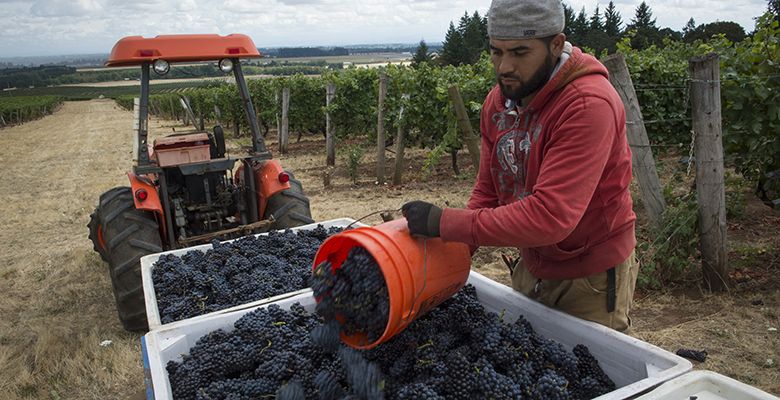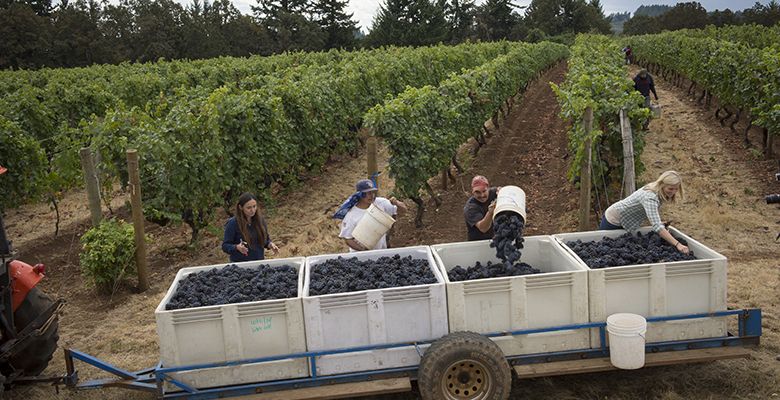Harvest Heats Up
Early crush due to warmer growing season
By David Bates
The crush of 2015 is on — although, by the time you read this, it may actually be history.
Prospects vary depending on the region and varietal, of course, but from the Columbia Gorge to Southern Oregon, “early” is the word this season, with crews harvesting vineyards as many as three weeks before the more-typical mid- to late-September crush.
Since we were enjoying strawberries before Memorial Day, it’s hardly a surprise that Oregon’s grape harvest, for many, started in late August.
Thanks to a hot summer, many varietals ripened two to three weeks early, an anomaly that — at least in the Pinot-rich Willamette Valley — last occurred in 1992, winemakers say.
For those who didn’t irrigate during the drought, that may mean lighter clusters and lower juice yields in some cases, but for the most part, vineyard managers say a hot summer isn’t necessarily bad for vintages.
In Yamhill County, 36-year veteran viticulturist Allen Holstein of Argyle Winery still has his hand-typed notes from 1992. That year, picking started Aug. 25 — almost the very date his crews started in August’s final week this year, picking almost 500 linear miles of grapevine rows, spread across 300 acres in three different locations.
So how was the wine after the last comparable heat wave?
“Ninety-two turned out to be perfectly acceptable, as a matter of fact,” Holstein said. “The wines held up over time better than some other vintages that were more flash-in-the pan. I always say that the best vintage is the one where the wine sells. If it doesn’t, you hear about it.”
Wine Enthusiast gave Oregon’s 1992 wines a “very good” rating on its vintage list. Winemakers have honed their craft since then, as evidenced by vintages in “superb” territory in recent years and rave reviews for the 2014 vintage, also produced in above average temperatures.
“It’s going hot and fast and compressed,” said Columbia Gorge Winegrowers President Brian McCormick, whose Memaloose Wines produces 20 varietals on both sides of the Columbia River near Lyle. “It’s a very dynamic year.”
Erath Winery in Yamhill County was among those that had an early harvest, according to spokesman Ryan Pennington.
“I’m hearing that flavor development is occurring at relatively low sugar levels, which should contribute to beautifully complex wines with relatively modest alcohol levels,” he said.
Chris Lake of the Southern Oregon Wine Institute said most of the larger vineyards in the warmer regions started early. But he adds that — because there are more than 150 microclimates south of Eugene — vineyards in cooler areas like Elkton and the Illinois River Valley didn’t see grapes ripen until early September, meaning a late or even early October harvest.
“I would say that we are, on average, three weeks earlier than normal in ripening our grapes,” said Lake. “Both volume and quality appear to be normal to above normal.”
There are a few areas where Mother Nature knocked volume a notch. Some Ashland-area vineyards were damaged by hail in early July. And in the Gorge, wineries are still reeling from November’s freak deep-freeze, when several unusually balmy days were followed by an overnight plummet into single digits.
“November was awful,” said Rich Cushman of Viento Wines. “There’s been a lot of damage to vines like Syrah, Tempranillo, sort of in the cooler part of the Gorge. My feeling is that those vines shouldn’t have been planted here anyway. Riesling, Chardonnay, Pinot Gris and Pinot Noir came through pretty well.”
And as Northwest winemakers and growers know well, the weather can turn suddenly.
But the long-term forecast by the National Oceanic and Atmospheric Administration calls for “warmer than normal” conditions in the West, with the best odds for that outlook here in the Pacific Northwest. That prediction has winemakers and industry insiders discussing a repeat — or something very close to it — of 2014, a record-busting year the Oregon Wine Board boldly credits with producing “the vintage of a lifetime.”
Such a grand sentiment would be a perfect way to celebrate the 50th anniversary of the first planting of Yamhill County’s Pinot Noir grapes by David Lett in February 1965. He’d landed in Oregon after a search for the perfect place to plant the French variety.
Fifty years later, more than 17,000 acres of Pinot Noir blanket the north valley, and Oregon boasts a $3.3 billion wine industry.
Greg Jones, a Southern Oregon University climatologist who has spent decades studying the interaction between climate and viticulture, calls the early start definitely “unusual.”
It is not, however, just a local event.
“This is not only happening here,” he said. “The harvest last year in Australia was one of the earliest on record, and the harvest in Europe this year is considered to be one of the earliest on record. It’s global in terms of wine harvests, the growing season being very warm, and the harvest being much earlier than normal.”
That’s not to say climate change means an August wine grape harvest is the new norm.
“It’s too early to say that,” says Viento’s Cushman, a veteran of 35 Oregon vintages. “It kind of frightens me that it could be the new norm.”
Even within the context of a warmer planet, variability at the local level can still be a factor, Jones cautions.
“Two years in a row of really early harvest doesn’t make a new norm,” he said. “However, if you look at the trend, it has slowly been to earlier and earlier harvest.
“Climate is still variable. It’s still changing. So there could be years that push it back,” Jones continued.” I think we are trending to earlier, but I just think there is some variability still in the system.”
Argyle’s Holstein agrees.
“I don’t deny man-induced climate change, but that’s what it is, is change,” he said. “It was four short years ago that we didn’t finish harvest until Nov. 5. So I think we’ll have variation. We’ll have more in August, and we’ll have more in November.”
One thing is certain: No one contacted for this story expects to be harvesting grapes this November.
David Bates is a regular contributor for the News-Register and a freelance writer who lives in McMinnville.














